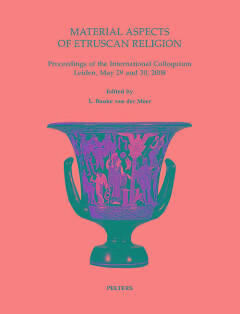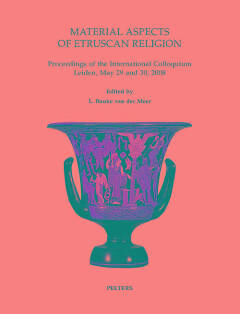
- Afhalen na 1 uur in een winkel met voorraad
- Gratis thuislevering in België vanaf € 30
- Ruim aanbod met 7 miljoen producten
- Afhalen na 1 uur in een winkel met voorraad
- Gratis thuislevering in België vanaf € 30
- Ruim aanbod met 7 miljoen producten
Zoeken
Material Aspects of Etruscan Religion
Proceedings of the International Colloquium Leiden, May 29 and 30, 2008
Der Meer Van
€ 65,00
+ 130 punten
Omschrijving
The articles in this publication are presentations given during and offered to the Colloquium Material Aspects of Etruscan Religion, organised by the Faculty of Archaeology of Leiden University on 29 and 30 May 2008. They shed much new light upon religious aspects of sanctuaries, cities, settlements, necropoles, and tombs in Etruria, in the Po valley and in Campania. Also several, hitherto unpublished artefacts with ritual representations are commented on. A new analysis of the role, gestures and instruments of haruspices (divination experts) suggests that Etruscan divination is of Near Eastern origin. Interdisciplinary research on the function of litui proves that this curved staff of priests (but not of seers) probably originates also from the Near East. Finally, the religious background of Etruscan theatrical plays, always related to historical events in Roman history, is analysed. This BABESCH Supplement casts light on Etruscan gods, the process of anthropomorphisation, the cults, votive deposits, the cult places, also in necropoles, architectural decoration of temples and the relationship with representations on vases in the Faliscan border area of Etruria, rituals, and attributes of seers and priests. Further a new typology of altars is included. Extremely important are the results of very recent excavations in Tarquinia, at Gravisca, a multicultural harbour sanctuary near Tarquinia, at Marzabotto and several other places. The introduction sketches the main lines of the development of Etruscan religion with references to the contents of the colloquium papers.
Specificaties
Betrokkenen
- Auteur(s):
- Uitgeverij:
Inhoud
- Aantal bladzijden:
- 164
- Taal:
- Engels
- Reeks:
- Reeksnummer:
- nr. 16
Eigenschappen
- Productcode (EAN):
- 9789042923669
- Verschijningsdatum:
- 17/06/2010
- Uitvoering:
- Paperback
- Formaat:
- Trade paperback (VS)
- Afmetingen:
- 208 mm x 272 mm
- Gewicht:
- 612 g

Alleen bij Standaard Boekhandel
+ 130 punten op je klantenkaart van Standaard Boekhandel
Beoordelingen
We publiceren alleen reviews die voldoen aan de voorwaarden voor reviews. Bekijk onze voorwaarden voor reviews.











